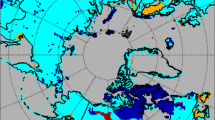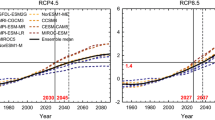Abstract
Active layer thickness (ALT) is critical to the understanding of the surface energy balance, hydrological cycles, plant growth, and cold region engineering projects in permafrost regions. The temperature at the bottom of the active layer, a boundary layer between the equilibrium thermal state (in permafrost below) and transient thermal state (in the atmosphere and surface canopies above), is an important parameter to reflect the existence and thermal stability of permafrost. In this study, the Geophysical Institute Permafrost Model (GIPL) was used to model the spatial distribution of and changes in ALT and soil temperature in the Source Area of the Yellow River (SAYR), where continuous, discontinuous, and sporadic permafrost coexists with seasonally frozen ground. Monthly air temperatures downscaled from the CRU TS3.0 datasets, monthly snow depth derived from the passive microwave remote-sensing data SMMR and SSM/I, and vegetation patterns and soil properties at scale of 1:1000000 were used as input data after modified with GIS techniques. The model validation was carried out carefully with ALT in the SAYR has significantly increased from 1.8 m in 1980 to 2.4 m in 2006 at an average rate of 2.2 cm yr−1. The mean annual temperature at the bottom of the active layer, or temperature at the top of permafrost (TTOP) rose substantially from −1.1°C in 1980 to −0.6°C in 2006 at an average rate of 0.018°C yr−1. The increasing rate of the ALT and TTOP has accelerated since 2000. Regional warming and degradation of permafrost has also occurred, and the changes in the areal extent of regions with a sub-zero TTOP shrank from 2.4×104 to 2.2×104 km2 at an average rate of 74 km2 yr−1. Changes of ALT and temperature have adversely affected the environmental stability in the SAYR.
Similar content being viewed by others
References
Anisimov O A, Shiklomanov N I, Nelson F E. 1997. Global warming and active-layer thickness: Results from transient general circulation models. Glob Planet Change, 15: 61–77
Cai Y, Li D L, Tang M C. 2003. Decadal temperature changes over Qinghai-Xizang Plateau in recent 50 years. Plateau Meterol, 22: 464–470
Che T, Li X, Jin R, et al. 2008. Snow depth derived from passive microwave remote-sensing data in China. Annals Glaciol, 49: 145–154
Cheng G D. 1984. Problems on zonation of high-elevation permafrost (in Chinese). Acta Geograph Sin, 39: 185–193
Cheng G D, Wu T H. 2007. Responses of permafrost to climate change and their environmental significance, Qinghai-Tibet Plateau. J Geophys Res, 112: F02S03
Cheng W M, Zhao S M, Zhou C H, et al. 2012. Simulation of the decadal permafrost distribution on the Qinghai-Tibet Plateau (China) over the past 50 years. Permafrost Periglac Process, 23: 292–300
Guglielmin M, Ellis C J E, Cannone N. 2008. Active layer thermal regime under different vegetation conditions in permafrost areas. A case study at Signy Island (Maritime Antarctica). Geoderma, 144: 73–85
Guo D L, Wang H J, Li D. 2012. A projection of permafrost degradation on the Tibetan Plateau during the 21st century. J Geophys Res, 117: D05106
Jin H J, Yu Q H, Wang S L, et al. 2008. Changes in permafrost environments along the Qinghai-Tibet engineering corridor induced by anthropogenic activities and climate warming. Cold Reg Sci Technol, 53: 317–333
Jin H J, He R X, Cheng G D, et al. 2009. Changes in frozen ground in the Source Area of the Yellow River on the Qinghai-Tibet Plateau, China, and their eco-environmental impacts. Environ Res Lett, 4: 1–11
King L, Herz T, Hartmann H, et al. 2006. The PACE monitoring strategy: A concept for permafrost research in Qinghai-Tibet. Quatern Int, 154–155: 149–157
Li R, Zhao L, Ding Y J, et al. 2012. Temporal and spatial variations of the active layer along the Qinghai-Tibet Highway in a permafrost region. Chin Sci Bull, 57: 4609–4616
Li X, Cheng G D. 1999. A GIS-aided response model of high altitude permafrost to global change, Sci China Ser D-Earth Sci, 42: 72–79
Li X, Cheng G D, Lu L. 2005. Spatial analysis of air temperature in the Qinghai-Tibet Plateau. Arctic Antarctic Alpine Res, 37: 246–252
Li X, Cheng G D, Jin H J, et al. 2008. Cryospheric change in China. Glob Planet Change, 62: 210–218
Liang S H, Wan L, Li Z M, et al. 2007. The effect of permafrost on alpine vegetation in the source regions of the Yellow River (in Chinese). J Glaciol Geocryol, 29: 45–52
Ling F, Zhang T J. 2003. Impact of the timing and duration of seasonal snow cover on the active layer and permafrost in the Alaskan Arctic. Permafrost Periglac Process, 14: 141–150
Liu T L. 1983. A summarization of formulas of calculating frozen or melted depth abroad (in Chinese). J Glaciol Geocryol, 5: 85–95
Luo D L, Jin H J, Jin R, et al. 2011. The extraction of watershed characteristics of the Source Area of Yellow River based on SRTM DEM with ArcGIS, IEEE (in Chinese). IEEE Xplore: International Conference on Remote Sensing, Environment and Transportation Engineering (RSETE2011), Nanjing, China. doi: 10.1109/RSETE.2011.5964645
Luo D L, Jin H J, Lin L, et al. 2012a. New progress on permafrost temperature and thickness in the source area of the Huanghe River (in Chinese). Scient Geograph Sin, 32: 898–904
Luo D L, Jin H J, Lin L, et al. 2012b. Degradation of permafrost and cold-environments on the interior and eastern Qinghai Plateau (in Chinese). J Glaciol Geocryol, 34: 538–546
Luo D L, Jin H J, Lin L, et al. 2013. Distributive features and controlling factors of permafrost and the active layer thickness in the Bayan Har Mountains along the Qinghai-Kangding Highway on Northeastern Qinghai-Tibet Plateau (in Chinese). Scient Geograph Sin, 33: 635–640
Ma L J, Qin D H. 2012. Spatial-Temporal characteristics of observed key parameters for snow cover in China during 1957–2009 (in Chinese). J Glaciol Geocryol, 34: 1–11
Mitchell T D, Jones P D. 2005. An improved method of constructing a database of monthly climate observations and associated high-resolution grids. Int J Climatol, 25: 693–712
Nan Z T, Li S X, Cheng G D. 2005. Prediction of permafrost distribution on the Qinghai-Tibet Plateau in the next 50 and 100 years. Sci China Ser D-Earth Sci, 48: 797–804
Nelson F E, Outcalt S I. 1987. A computational method for prediction and regionalization of permafrost. Arct Alp Res, 19: 279–288
Oelke C, Zhang T J. 2007. Modeling the active-layer depth over the Tibetan Plateau. Arct Antarct Alp Res, 39: 714–722
Pang Q Q, Cheng G D, Li S X, et al. 2009. Active layer thickness calculation over the Qinghai-Tibet Plateau. Cold Reg Sci Technol, 57: 23–28
Riseborough D, Shiklomanov N, Etzelmüller B, et al. 2008. Recent advances in permafrost modelling. Permafrost Periglac Process, 19: 137–156
Romanovsky V E, Osterkamp T E. 1997. Thawing of the active layer on the Coastal Plain of the Alaskan Arctic. Permafrost Periglac Process, 8: 1–22
Sazonova T S, Romanovsky V E. 2003. A model for regional-scale estimation of temporal and spatial variability of active layer thickness and mean annual ground temperatures. Permafrost Periglac Process, 14: 125–139
Sazonova T S, Romanovsky V E. 2004. Permafrost dynamics in the 20th and 21st centuries along the East Siberian transect. J Geophys Res, 109: D01108
Shiklomanov N I, Nelson F E. 1999. Analytic representation of the active layer thickness field, Kuparuk River Basin, Alaska. Ecol Model, 123: 105–125
Shiklomanov N, Nelson F, Streletskiy D, et al. 2008. The Circumpolar Active Layer Monitoring (CALM) program: Data collection, management, and dissemination strategies. In: Kane D L, Hinkel K M, eds. Proc 9th Int Conf Permafrost, 2: 1–6
Shiklomanov N I, Streletskiy D A, Nelson F E, et al. 2010. Decadal variations of active-layer thickness in moisture-controlled landscapes, Barrow, Alaska. J Geophys Res, 115: G00I04
Wei S G, Dai Y J, Liu B Y, et al. 2012. A soil particle-size distribution dataset for regional land and climate modelling in China. Geoderma, 171–172: 85–91
Smith M W, Riseborough D W. 2002. Climate and the limits of permafrost: A zonal analysis. Permafrost Periglac Process, 13: 1–15
Streletskiy D A, Shiklomanov N I, Nelson F E. 2012. Spatial variability of permafrost active-layer thickness under contemporary and projected climate in Northern Alaska. Polar Geography, 35: 95–116
van Everdingen R O, ed. 2005. Multi-languge Glossary of Permafrost and Related Ground-ice Terms. Boulder: National Snow and Ice Data Center/World Data Center for Glaciology. 222
Wu Q B, Zhang T J. 2008. Recent permafrost warming on the Qinghai-Tibetan Plateau. J Geophys Res, 113: D13108
Wu J C, Sheng Y, Wu Q B, et al. 2010. Processes and modes of permafrost degradation on the Qinghai-Tibet Plateau. Sci China Earth Sci, 53: 150–158
Wu Q B, Zhang T J. 2010. Changes in active layer thickness over the Qinghai-Tibetan Plateau from 1995 to 2007. J Geophys Res, 115: D09107
Wu Q B, Zhang T J, Liu Y Z. 2012. Thermal state of the active layer and permafrost along the Qinghai-Xizang (Tibet) Railway from 2006 to 2010. Cryosphere, 6: 607–612
Xie Y, Zeng Q. 1983. Climatic conditions for the occurrence of permafrost in the Qinghai-Tibet Plateau (in Chinese). In: Proceedings of the Second National Conference on Permafrost. Lanzhou: Gansu People’s Publishing House. 13–20
Xu X Z, Wang J C, Zhang L X. 2010. Physics of Frozen Soils (in Chinese). Beijing: Science Press. 84–90
Yi X S, Yin Y H, Li G S, et al. 2011. Temperature variation in recent 50 years in the three-river headwaters region of Qinghai Province (in Chinese). Acta Geograph Sin, 66: 1451–1465
Zhang T J. 2005. Spatial and temporal variability in active layer thickness over the Russian Arctic drainage basin. J Geophys Res, 110: D16101
Zhao L, Wu Q B, Marchenko S S, et al. 2010. Thermal state of permafrost and active layer in Central Asia during the international polar year. Permafrost Periglac Process, 21: 198–207
Zhou J, Kinzelbach W, Cheng G D, et al. 2013. Monitoring and modeling the influence of snow pack and organic soil on a permafrost active layer, Qinghai-Tibetan Plateau of China. Cold Region Sci Tech, 90–91: 38–52
Zhou Y W, Qiu G Q, Guo D X, et al. 2000. Frozen ground in China (in Chinese). Beijing: Science Press. 63–91
Author information
Authors and Affiliations
Corresponding author
Rights and permissions
About this article
Cite this article
Luo, D., HuiJun, J., Marchenko, S. et al. Distribution and changes of active layer thickness (ALT) and soil temperature (TTOP) in the source area of the Yellow River using the GIPL model. Sci. China Earth Sci. 57, 1834–1845 (2014). https://doi.org/10.1007/s11430-014-4852-1
Received:
Accepted:
Published:
Issue Date:
DOI: https://doi.org/10.1007/s11430-014-4852-1




